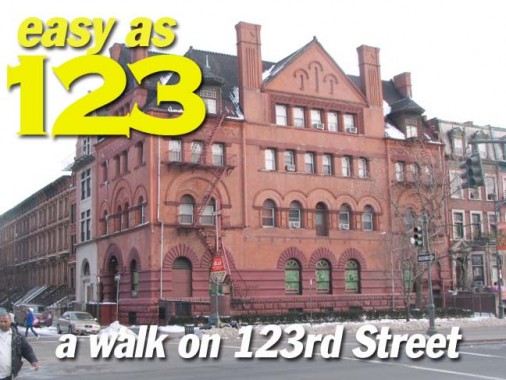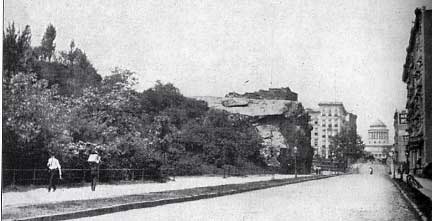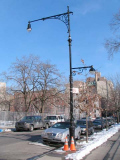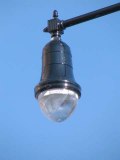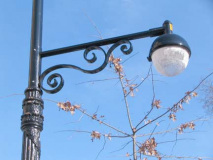I fell onto West 123rd Street almost by accident, but it was most likely a consequence of the men who built the parks in the mid-19th Century, the general topography, and the engineers who laid out NYC’s street grid in 1811. The street runs through the northern stretches of Morningside Heights, the neighborhood built around Morningside Park, which was designed, like the larger Central Park to the south, by Frederick Olmsted and Calvert Vaux, opening in 1887. The park runs north from Cathedral Parkway (West 110th) to West 123rd and straddles a high hill. As it happens, West 123rd is the only street between 110th and 125th (Martin Luther King Boulevard) to enable pedestrian passage from Broadway east to East Harlem.
Two views of West 123rd Street between Amsterdam and Morningside Avenues in the late 19th Century. From FNY’s Manhattanville page: West 123rd is the site of a massive glacial rock outcropping; these occur frequently in northern Manhattan and in the Bronx. A defense fortification, Blockhouse No. 4, was built here in 1812 when it appeared that the British would attack New York City, having sacked and burned Washington, DC. The British, however, got no closer than Stonington, CT during the War of 1812. This blockhouse was torn down decades ago; however, one has been preserved in Central Park. photos: Manhattanville, Old Heart of West Harlem, Eric K. Washington, Arcadia 2002
The outcropping is still there, supporting PS 36, an engineering marvel completed in 1967.
West 123rd between Amsterdam and Morningside Avenues has been given a brand new (as of February 2010) Corvington lampposts, based on earler versions from the early 20th Century. The Bell luminaire has also been brought back over the past 15 years and may be the handsomest lighting device ever designed. These posts also have a set of attached lamps for illuminating sidewalks (these were not featured on the original posts that were installed between 1910 and 1950).
Exterior artwork for the Columbia School for Math, Science and Engineering, which opened in the fall of 2007; the school serves”academically talented students who have an interest in a rigorous and demanding program focusing on math, science, and engineering.”
The buzz on the street was that longer and warmer days were here. However, nearly two feet of snow fell on NYC a few days after this walk.
The casual magnificence of an apartment building constructed between 1895-1915, SE corner Morningside Avenue and West 123rd Street; one of thousands of buildings that will not get a Landmarks Preservation Commission nod, will probably never gain the attention of Christopher Gray in the NY Times Streetscapes column, or a couple of lines in the AIA Guide to New York City; yet it remains a bulwark against the greatly inferior architecture of the 21st Century (as far as multifamily buildings go, anyway) and a silent accuser against the perfidy of developers who build things like this.
Brownstones on West 123rd between Morningside and Manhattan Avenues. The street does not differ greatly from most uptown side streets, which feature thousands of buildings like this, some well kept, some falling into disrepair.
Hancock Park is one of those uptown triangular spaces caused by the course of St. Nicholas Avenue, a major road that predated the street grid, that meanders over upper Manhattan in a general NW-north course. This triangle at West 123rd, St. Nicholas and Manhattan Avenues, honors Winfield Scott Hancock, Civil War general and Democratic presidential nominee in 1880 (he lost to James Garfield).
The northernmost address on Manhattan Avenue, 565 at West 124th across from Hancock Square, is known as the Mannie L. Wilson Towers. Rev. Wilson was the pastor of the Convent Avenue Baptist Church at West 145th and a former president of the Council of Churches of the City of New York. This handsome building, with its rounded corner, is home to the Mannie L. Wilson Primary Care Center, which provides comprehensive medical and dental services to elderly and their families in central Harlem. The building is the former Sydenham Hospital, closed by the Ed Koch administration in 1980.
Continuing on West 123rd, at the corner of Frederick Douglass Boulevard (formerly 8th Avenue) is a pleasant 5-story residential building with light blond brick. Note the window treatments are different on the top four floors.
Between Frederick Douglass and Adam Clayton Powell Boulevards, an old frame building, likely older than the attached houses on the block, is worse for wear after decades, perhaps over a century standing.
Adam Clayton Powell, Jr. Boulevard at West 123rd. It’s rare that a restaurant advertises what it doesn’t serve.
New York State Governor Eliot Spitzer was elected in November 2006, but was forced from office in a sex scandal (he was caught with a hooker) in March 2008; his lieutenant governor, David Paterson, ascended to office but has been beset by numerous problems of his own and was hanging on by a fingernail in March 2010. March seems to be a bad month for NYS governors.
As it turned out Paterson’s stint was notable by his being the first African American NYS governor, and the first to wear a beard in close to a century. When his poll numbers went down, off came the beard. He was succeeded by Andrew Cuomo, son of former governor Mario, in 2011; Paterson, as of January 2012, was a WOR radio talk show host.
Adam Clayton Powell Boulevard between West 122nd and West 123rd Streets. The brownstones here, and many in Harlem, are constructed from Triassic sandstone, with its distinctive brown color deriving from red ion ore contained in the mix. Most brownstones are between 20 and 25 feet wide, and because they were originally built for well to do residences, some of their interiors remain executed with fine materials and are elaborately apportioned and decorated.
Have you ever had a glass sandwich? This pair of brownstones know the feeling as they are surrounded by 21st Century buildings between Adam Clayton Powell Boulevard and Malcolm X Boulevard.
Approaching Malcolm X Boulevard we see the high spired Ephesus 7th Day Adventist Church, constructed as the Reformed Low Dutch Church of Harlem by architect John Rochester Thomas in 1894-1895.
Built as the Harlem Club in 1889 this is presently the Bethelite Community Baptist Church.
3/4/10
